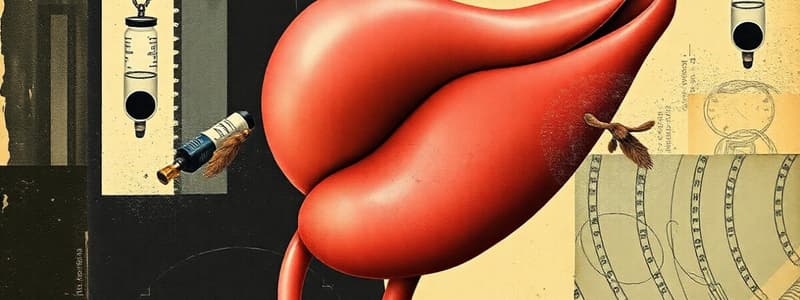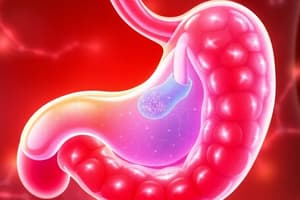Podcast
Questions and Answers
What factor is commonly linked to the development of Type 2 diabetes?
What factor is commonly linked to the development of Type 2 diabetes?
- Increased insulin receptor numbers
- High levels of physical activity
- Obesity (correct)
- Low genetic predisposition
What is the primary indicator for diagnosing diabetes?
What is the primary indicator for diagnosing diabetes?
- Serum insulin levels
- Fasting glucose level over 126 mg/dL (correct)
- HbA1c level below 5%
- Random glucose level below 200 mg/dL
Which long-term consequence is NOT associated with nonenzymatic glycosylation in diabetes?
Which long-term consequence is NOT associated with nonenzymatic glycosylation in diabetes?
- Hyaline arteriolosclerosis
- Glomerulosclerosis
- Hyperosmolar non-ketotic coma (correct)
- Atherosclerosis
Which of the following describes a significant change during the progression of Type 2 diabetes?
Which of the following describes a significant change during the progression of Type 2 diabetes?
What is a clinical manifestation of diabetes that is often overlooked?
What is a clinical manifestation of diabetes that is often overlooked?
What is the role of aldose reductase in the pathology of diabetes?
What is the role of aldose reductase in the pathology of diabetes?
Which consequence of diabetes primarily affects the kidneys?
Which consequence of diabetes primarily affects the kidneys?
What percentage of pancreatic neoplasms are accounted for by islet cell tumors?
What percentage of pancreatic neoplasms are accounted for by islet cell tumors?
What is the primary role of insulin secreted by beta cells in the islets of Langerhans?
What is the primary role of insulin secreted by beta cells in the islets of Langerhans?
Which immune response is primarily responsible for the destruction of beta cells in Type 1 Diabetes Mellitus?
Which immune response is primarily responsible for the destruction of beta cells in Type 1 Diabetes Mellitus?
In Type 1 Diabetes Mellitus, what leads to hyperglycemia during fasting states?
In Type 1 Diabetes Mellitus, what leads to hyperglycemia during fasting states?
What is a characteristic complication of Type 1 Diabetes Mellitus that may arise during periods of stress?
What is a characteristic complication of Type 1 Diabetes Mellitus that may arise during periods of stress?
Which of the following features is NOT typically associated with Type 1 Diabetes Mellitus?
Which of the following features is NOT typically associated with Type 1 Diabetes Mellitus?
What is the mechanism through which glucagon increases blood glucose levels?
What is the mechanism through which glucagon increases blood glucose levels?
Which of the following is a sign of diabetic ketoacidosis?
Which of the following is a sign of diabetic ketoacidosis?
What best describes the pathophysiology of Type 2 Diabetes Mellitus?
What best describes the pathophysiology of Type 2 Diabetes Mellitus?
Flashcards
Islets of Langerhans
Islets of Langerhans
Clusters of cells within the pancreas responsible for hormone production.
Insulin
Insulin
A major anabolic hormone secreted by beta cells in the islets of Langerhans. It promotes glucose uptake by tissues, leading to increased glycogen synthesis, protein synthesis and lipogenesis.
Glucagon
Glucagon
A hormone secreted by alpha cells in the islets of Langerhans that opposes insulin. It increases blood glucose levels by promoting glycogenolysis and lipolysis.
Type 1 Diabetes Mellitus
Type 1 Diabetes Mellitus
Signup and view all the flashcards
Type 2 Diabetes Mellitus
Type 2 Diabetes Mellitus
Signup and view all the flashcards
Diabetic Ketoacidosis
Diabetic Ketoacidosis
Signup and view all the flashcards
Hyperglycemia
Hyperglycemia
Signup and view all the flashcards
Fruity smelling breath
Fruity smelling breath
Signup and view all the flashcards
Type 1 Diabetes
Type 1 Diabetes
Signup and view all the flashcards
Type 2 Diabetes
Type 2 Diabetes
Signup and view all the flashcards
Fasting Glucose Test
Fasting Glucose Test
Signup and view all the flashcards
Glucose Tolerance Test (GTT)
Glucose Tolerance Test (GTT)
Signup and view all the flashcards
Diabetic Microangiopathy
Diabetic Microangiopathy
Signup and view all the flashcards
Glycated Hemoglobin (HbA1c)
Glycated Hemoglobin (HbA1c)
Signup and view all the flashcards
Insulin Resistance
Insulin Resistance
Signup and view all the flashcards
Study Notes
Endocrine Pancreas
- Composed of clusters of cells called islets of Langerhans
- Each islet contains multiple cell types, each producing a unique hormone
- Insulin is produced by beta cells, located centrally within the islets
- Insulin is a major anabolic hormone, increasing glucose uptake by skeletal muscle and adipose tissue, reducing serum glucose
- Increased glucose uptake leads to glycogen, protein, and lipid synthesis
- Glucagon is produced by alpha cells, acting in opposition to insulin, increasing blood glucose levels during fasting (via glycogenolysis and lipolysis)
Type 1 Diabetes Mellitus
- Characterized by insulin deficiency due to autoimmune destruction of beta cells
- Often caused by T lymphocytes
- Inflammation of islets is common
- Associated with HLA-DR3 and HLA-DR4
- Autoantibodies against insulin are often present years before clinical diagnosis
- Initial symptoms appear in childhood
- High blood glucose, reduced glucose uptake by fat and skeletal muscle due to lack of insulin
- Hyperglycemia is a key characteristic
Type 2 Diabetes Mellitus
- Predominantly an end-organ insulin resistance disorder
- Characterized by hyperglycemia
- Accounts for 90% of diabetes cases, most prevalent in middle-aged obese adults.
- Obesity is linked to decreased insulin receptors
- High genetic predisposition
- Early in the disease, insulin levels may be elevated, but later, beta cell exhaustion leads to insulin deficiency
- Often clinically silent in early stages; polyuria, polydipsia, and hyperglycemia are common clinical features
- Diagnosis based on random glucose levels exceeding 200 mg/dL, fasting glucose over 126 mg/dL or glucose tolerance test showing over 200 mg/dL two hours after glucose consumption
Long-Term Consequences of Diabetes
- Nonenzymatic glycosylation (NEG) of vascular basement membranes leads to atherosclerosis, cardiovascular disease, and peripheral vascular disease.
- NEG of small vessels leads to hyaline arteriolosclerosis, affecting kidneys and resulting in small scarred kidneys.
- NEG of hemoglobin forms glycated hemoglobin (HbA1c), a marker of blood glucose control.
- Osmotic damage occurs as glucose enters Schwann cells, pericytes, and lens; this leads to nerve damage, blindness, and cataracts.
Pancreatic Endocrine Neoplasms
- Tumors of islet cells, a relatively rare component of pancreatic neoplasms (<5% of pancreatic tumors)
- Often associated with MEN-1 syndrome, alongside parathyroid hyperplasia and pituitary adenomas
- Insulinomas are characterized by episodic hypoglycemia, relieved by glucose administration
- Gastrinomas cause treatment-resistant peptic ulcers (Zollinger-Ellison syndrome)
- Somatostatinomas result in achlorhydria and cholelithiasis with steatorrhea
- VIPomas manifest as watery diarrhea, hypokalemia, and achlorhydria.
Studying That Suits You
Use AI to generate personalized quizzes and flashcards to suit your learning preferences.




